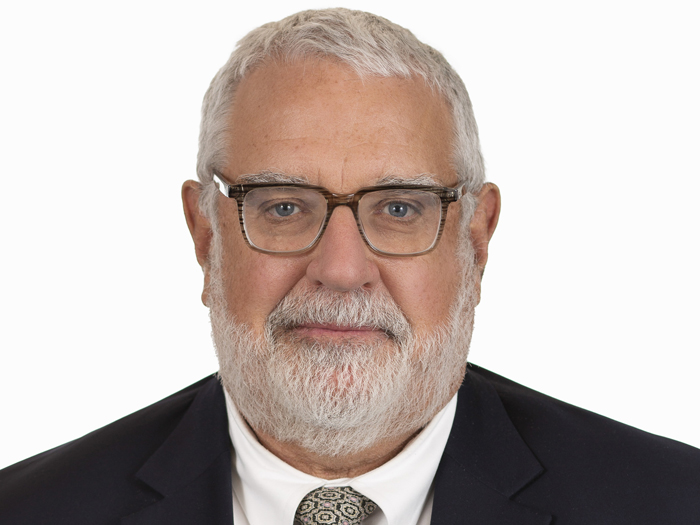10 Questions for Pennsylvania Lumbermens’ John Smith, Part 1

In October 2022, John Smith, president and CEO of Pennsylvania Lumbermens Mutual Insurance Company, sat down for an interview with Dan Reynolds, editor-in-chief of Risk & Insurance®. What follows is part one of that interview, edited for length and clarity.
Risk & Insurance: John, we were wondering, for starters, if we could just ask you a little bit about your background.
John Smith: I’ve been in the insurance business for 47 years. I have been with Pennsylvania Lumbermens for 24 years. Prior to coming to PLM, I spent time with Aetna, CNA and General Accident in profit center leadership roles in obviously large companies.
Along came an opportunity to step into a CEO succession plan with a small company and a niche player. I always wanted to try my hand at that, so I took the opportunity to make the change and haven’t looked back. It’s been a great ride, quite frankly.
I have an undergraduate degree in accounting, master’s in business administration from University of Pittsburgh; I am a lifelong learner, CPCU, ARE, CIC, CRM, that type of thing. So I have very strong feelings about education and continuing education.
The wood niche is an interesting place to operate. People view us as more a member of the wood industry than they do the insurance industry, when you get right down to it.
We’ve been doing it for 127 years, and while people don’t recognize Pennsylvania Lumbermens or PLM all that quickly, you couldn’t walk into a wood-related risk anywhere in the United States, mention our name, and not get instantaneous brand recognition. That’s what happens when you focus on a niche for as long as we have. So it’s very interesting. It’s just a great company.
R&I: John, can you describe this generally — your customer base or the spectrum of it?
JS: We’re the largest writers of wood-related business in America. If you think about a tree growing in a forest — we don’t do much logging or any logging to speak of, but once that tree is dragged out of the forest, it goes into a sawmill, and that’s where our niche begins.
We then follow the wood out of the sawmill, into the wood manufacturing process. So, it could be turned into fine furniture, toothpicks, millwork or anything in between.
Then we also write retail and wholesale lumberyards throughout the country. Those family businesses that compete with Home Depot and Lowe’s on a regular basis are what we focus on.
If you look at the top hundred lumberyards in America, we probably insure 45 of them. Take any one of those three segments and we actually have the largest wood book in any of the segments, whether it’s retail lumberyard, sawmills or light wood manufacturing.
We write all lines of coverage except for workers’ comp. We run the workers’ comp through our agency. We’ve only been doing that for the last couple years.
We don’t write anything but wood. We write it in 48 continental states, but are licensed in all 50.
We use a unique distribution model we call open brokerage. If you had a property casualty license and you submitted a piece of wood business to us, we would evaluate that risk, and if we were interested, we’d provide you a quote. There’s no agency licensing, there’s no premium commitment or responsibility.
It’s pure brokerage, “open brokerage,” yet if you look at us from the top down, we look more like a direct writer. Our database right now includes about 65,000 prospects. We are working on doubling that number in the next six months.
Last month, we sent out 125,000 emails on 45 different topics to insureds and prospects in the lumber niche and brokers that we’ve accumulated a list of. We are also becoming very active on social media. We will also do 200 broker and insured trade shows this year. Our goal is to create an environment where, whether it’s an insured, a prospect or a broker, when they think wood, they think “PLM.”
When you think equipment breakdown, you think of a specific company. We want to create that same environment within the insurance community. We think we have that name recognition, that strength in the wood industry already.
The agency is going to give us the opportunity to do some things that we don’t want to do on PLM paper. We don’t do logging at this point in time on PLM paper. There are segments of the logging piece that we wouldn’t mind putting on PLM paper, but we want to offer a total solution. So we’ll figure that out inside the agency and mold the two of them together.
There are a lot of other little things like that: Mulch and firewood manufacturing, pellets, recycled pallets, continuous dry kilns all fit in here.
R&I: We’re laypeople, but when we think about construction risk, we think about hot work, we think about sawdust and mitigating that side of things. Do you get into risk engineering and risk mitigation with those folks that you do underwrite or provide paper for?
JS: Heavily. You don’t write a sawmill without having a very tough and formidable underwriting and loss control program.
Early on, we tried to be gentle about applying our guidelines. Over the years, we found that doesn’t work — that you have to do it our way or find another insurance carrier.
The result is that we have turned a longtime losing sector into a profit center for PLM! Quite frankly, that didn’t happen until we got the pricing, underwriting and loss control risk management side right.
It’s interesting, we’re seeing a lot of generational change in our insurers. Most of them are family-owned businesses, and the younger generation seems much more willing — particularly the daughters that are taking over, which is happening more frequently — than the older generation to embrace risk management and loss control type operations.
We have 16 loss control professionals on staff, and we add to that 25 business development reps that have light loss control responsibility and actually inspect every risk before we quote it.
We’re working on an automated system for the small risks and a separate one to support and supplement our efforts on larger risks.
Initial feedback on the small account program, “Anytime Risk Management,” is positive. You walk your premises, complete an online form, take pictures and send it in to us anytime you want!
Our loss control people review it, give you a call and walk through it with you. There’s a whole host of videos and material, a risk management library that we manage for our insureds, where they can pull down different videos and podcasts and things of that nature.
R&I: A lot happened in the past couple years, John, with the pandemic and the ability of companies to be on site and be dialoging with their customers. Can you tell us — and now that we’re hopefully coming out of the pandemic, you still have a pretty substantial change in how everybody works — what does that look like?
When you think of your loss control officers and your business development folks interacting with customers, what has changed substantially in the past couple years that you’ve got your eye on and that you want to make sure you manage?
JS: We’re located in the Philadelphia area. I live in New Jersey, lots of friends in New York, and I think our view of COVID in this geographic area and in certain other geographic areas in the United States is pretty tough. A lot of deaths, a lot of sicknesses have occurred in our region. We tend to live closer to each other in the metropolitan areas, so I think the COVID pressures were different regionally.
As you travel the country, what you find is that different pockets of the country have different viewpoints on that.
We have a large segment of our customers that did not have much COVID exposure and didn’t really do much other than shut down for brief periods, but nothing that was extraordinary.
Well, we have other customers, for instance in downstate New York, where we couldn’t get in, and frankly, we understood that, which is why we came up with the Anytime Risk Management concept and started doing things remotely with iPhones and things of that nature.
We closed down our Philadelphia office. We told our people they had to be concerned about their own health, the health of their families and the health of PLM. I think we did a pretty good job as a company and the industry in making our way through COVID fairly well intact.
Now, keep in mind, and I’ll use Pennsylvania as an example, the governor closed the entire state immediately, including all the wood businesses, until someone realized, you can’t ship water and foodstuffs and medical supplies unless you ship it on pallets, and most pallets are made of wood. You got to have pallets. So almost immediately, they opened pallet business. Well, to build a pallet, you need wood. So the next thing that happened was sawmills were opened up, and that was within days of closing. It didn’t take long for someone to realize that we needed the housing economy to continue, and to build houses, you need building materials. So they were opened up.
The bulk of our insureds were not closed that long before they were reopened. We changed our marketing approach and learned a lot of lessons there.
This is an industry like the insurance business; its people are relationship-oriented. The people in the business belong to multiple associations and they go to multiple association meetings.
Of those 200 shows I mentioned earlier, we’ll do 90 wood trade shows this year. COVID shut that all down. So, you’ve got to think of different ways to market! Hence our expansion in online marketing.
It gave us the opportunity (or forced us) to test those things out and put those things in place. The result is that we really didn’t miss too much of a beat as far as the company’s concerned.
Our experience is very different than other companies you’ll talk to, other insurance companies you’ll talk to.
I think today in America, the environment is one where people are looking at things very much in opposition to each other. So while you and I have a certain view of COVID, that’s not necessarily shared by someone in Missouri or Kansas. I remember saying to one of our business development reps when we first put them back on the road, “Let’s make sure we’re socially distancing and not forcing our way in,” and this guy looked at me and said, “John, we’ve socially distanced in Missouri for most of our lives.”
I don’t know if you’ve flown recently, but you get on a plane today and the captain will announce, “Some people will be masking and we respect their wishes!” We did that almost from square one, saying to our people in Philadelphia, “Hey, it’s different elsewhere in the country, so let’s respect where they are and how they view COVID.” To our remote employees, we told them we understood they viewed COVID differently, but that they should respect the situation that Philadelphia-based employees endured.
At the same time, we encourage the vaccines for all. I think our people reacted well.
R&I: You mentioned, John, being able to market and approach different tiers of the industry and maybe get into smaller operators. This comes under the heading of opportunities you might be intrigued about or excited about as we head into 2023. What business opportunities as an underwriter are intriguing to you as you look ahead here?
JS: There is no particular order. We’re back out in front of people. We’ve got 11 trade shows this week that we’re doing. About half of them are broker trade shows, the other half are wood trade shows. So getting back out in front of people, getting back out in front of our clients and prospects creates opportunity.
We’re seeing unparalleled growth as we continue to focus on our niche. If you know what’s going on in the insurance industry, and you obviously do, there’s capacity problems on the property side and we have not had those constraints to speak of, so we’re seeing more business than ever before.
We think top-line growth is exciting and our market share continues to increase. The agency operation that we’re setting up, we’re moving away from just doing workers’ compensation in that operation to non-comp related business that we’re not interested in putting on PLM paper.
We get 1,600 submissions a year that we decline. Most of them are wood-related, but we decline them without quoting them because of risk quality. Our goal is to start sending them through the agency. So as a broker, maybe you’ll get a rejection notice from PLM, but you’ll get a quote from the agency on someone else’s paper. I think that creates opportunities for us and provides a win-win-win for the broker, insured and PLM.
The last thing is marketing. We’re taking on a lot of different challenges and new approaches in marketing. We’ve launched webinars, we’re upgrading our social media efforts, just a more visible approach on a broader basis.
We’ve taken a kinder, gentler approach to marketing towards brokers, which we’ve never really done too much of. We’re seeing a lot of business wander in from brokers we’ve never done business with before, and who didn’t know about us, because we’re starting to reach out to them. That’s been very successful for us.
I think what’s happening as well is that other companies are recognizing that, over the years, a wood risk wandered onto their books, and perhaps they are not as well equipped to understand the exposure and pricing approach, as well as have a reinsurance program that supports dramatic loss severity associated with wood. Many would like those risks to wander off to someplace else, and that’s okay with us. After all, wood burns, and it burns big. &
Dan Reynolds and John Smith continue their conversation in part two, available here.










